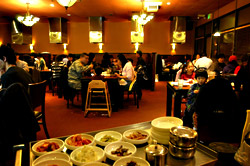At some point in the middle of every Korean meal, I become overwhelmed. A hundred-thousand Scoville units’ worth of chiles have electrified my mouth, and my taste buds crackle and spark each time they encounter the tang of fermented pickles anew. Garlic has filtered from my gut to my pores, and beer and capsaicin have set my endorphins coursing. I feel bloated, overstimulated, overly satisfied. But with so many plates of food to pick from, there’s no way I can stop eating.
If a recent Saturday night crowd is any evidence, Ka Won Korean Restaurant, on Highway 99 in Lynnwood, doesn’t have that effect on just me. Customers blocked the doorway and wandered from table to table hailing friends. Servers jogged through the aisles pushing shelved carts stacked with tiny white bowls. It was loud-laughing, gut-swelling anarchy.
A Korean-American friend had said this was her favorite place in the region, and shortly after my sister and I slid into one of the wood-paneled booths, its cushions comfortably ripped and the table scuffed with good use, I began to see why. Promising sign No. 1 was the Chinese-Korean strip mall behind which the restaurant is hidden. (I’ve eaten so many amazing meals in Asian strip malls over the years that they’ve redeemed suburbia for me.) Sign No. 2 was the mix of Korean-speaking diners: Twentysomethings apparently found the place hip enough to eat at with their friends; older people found the tastes true enough to spend their money on.
A third promising sign was the number and variety of beyond-barbecue dishes listed on the menu, which we browsed while sipping plastic glasses of toasted-barley tea. There were soft-tofu stews, broiled fish, and sautéed squid. Even the barbecued-meat section listed two kinds of uncured pork belly, regular and black pig, the latter currently starring on high-end Western menus as Kurobuta pork.
If you’re not sure how to make up a meal of all those dishes, Ka Won, like many Korean restaurants, offers prix-fixe dinners. My sister and I ordered the $34.95 combo for two, and it was impossible to see the table under all the plates that arrived: A choice of bulgogi or spicy pork; broiled mackerel; a fermented-soybean soup; an egg custard; a lettuce salad dressed in a chile-sesame vinaigrette; and, of course, rice and banchan, or side dishes. Four people could have dined on the feast.
And dined well. The soup, which arrived roiling furiously in a stone bowl, had huge flavor, the broth pungent with a heartier cousin of miso. The broiled mackerel was split in half, from teeth to tail, and set under the broiler until it browned to the edge of black. I’ve never been a huge fan of this style, but the cooks had chosen a mackerel that was oily enough to withstand the fierce heat without turning into leather. The thinly shaved bulgogi was dressed with a sweet, garlicky marinade; it cooked up into tender, crenellated beef. My favorite discovery of the evening was the soufflélike custard: The cooks had whisked eggs together with scallions and stock, then poured the mixture into a hot stone bowl so it bubbled and puffed up on its way to the table.
Some of the tables come with large electric woks, filled with simmering crimson broth, in which you can make “casseroles.” These range in price from $29.95 to $34.95 and are described as being for three people, though six is more like it. The most accessible pot for non-Koreans, our waitress advised, is the spicy broth with potstickerlike dumplings, but my friends and I went with the seafood casserole. It was loaded up with chrysanthemum greens and more varieties of seafood than you’d find at a QFC: an entire crab, seven kinds of shellfish, a small octopus, a bundle of halibut intestines (which, if you enjoy monkfish liver, you’ll like), a fish maw with its silky, rich meat. The thin broth was as spicy as it looked but didn’t overpower the seafood. Between sips, we peeled shrimp and waited for our tongues to recover.
The hit of the evening wasn’t the halibut intestines, surprisingly enough, it was the seafood pancake. A shallow cast-iron skillet the size of a medium pizza held a mass of sautéed onions, scallions, bay scallops, baby shrimp, and octopus tentacles, barely held together with flour and egg. We plucked off bites with our chopsticks and spooned a soy-vinegar sauce onto them.
I loved Ka Won most for its banchan. Each meal came with 10 tiny bowls containing things to munch on, which varied from creamy and bland (a mashed-potato salad, heavy on the mayo) to the incendiary (green chiles tossed in red-chile paste). And with the exception of some too-saucy cabbage kimchi, they were all fantastic: the ever-popular blanched mung bean sprouts tossed with a little sesame oil; fragrant fresh sesame leaves dressed with a little chile and garlic; the tiniest of crunchy dried anchovies candied and tossed with peanuts (a combination that sounds dreadful but is pure crack).
If you get barbecue at Ka Won, be sure to order at least two kinds or you won’t be able to grill your own meat at the table. Single orders of meat get quickly sautéed in the kitchen until just cooked, then sent out— no blackened edges, no caramelized marinade, no flavor. Twice I endured bland barbecue while staring at my neighbors, who were grilling up platters of half-frozen pork belly sliced into big, pink curls and long, paper-thin strips of marinated kalbi (beef short ribs), the crimson meat gorgeously streaked with fat. The smell was torture.






